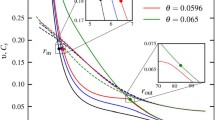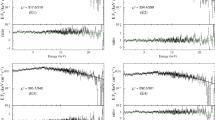Abstract
We study the global accretion-ejection solutions around a rotating black hole considering three widely accepted pseudo-Kerr potentials that satisfactorily mimic the space-time geometry of rotating black holes. We find that all the pseudo potentials provide standing shock solutions for large range of flow parameters. We identify the effective region of the shock parameter space spanned by energy (\(\mathcal{E}_{\text{in}}\)) and angular momentum (\(\lambda _{\text{in}}\)) measured at the inner critical point (\(x_{\text{in}}\)) and find that the possibility of shock formation becomes feeble when the viscosity parameter (\(\alpha \)) is increased. In addition, we find that shock parameter space also depends on the adiabatic index (\(\gamma \)) of the flow and the shock formation continues to take place for a wide range of \(\gamma \) as \(1.5 \le \gamma \le 4/3\). For all the pseudo potentials, we calculate the critical viscosity parameter (\(\alpha _{\text{shock}}^{\text{cri}}\)) beyond which standing shock ceases to exist and compare them as function of black hole spin (\(a_{k}\)). We observe that all the pseudo potentials under consideration are qualitatively similar as far as the standing shocks are concerned, however, they differ both qualitatively and quantitatively from each other for rapidly rotating black holes. Further, we compute the mass loss from the disc using all three pseudo potentials and find that the maximum mass outflow rate (\(R^{ \mathrm{max}}_{{\dot{m}}}\)) weakly depends on the black hole spin. To validate our model, we calculate the maximum jet kinetic power using the accretion-ejection formalism and compare it with the radio jet power of low-hard state of the black hole X-ray binaries (hereafter XRBs). The outcome of our results indicate that XRBs along the ‘outliers’ track might be rapidly rotating.








Similar content being viewed by others
References
Aktar, R., Das, S., Nandi, A.: Mon. Not. R. Astron. Soc. 453, 3414 (2015)
Aktar, R., Das, S., Nandi, A., Sreehari, H.: Mon. Not. R. Astron. Soc. 471, 4806 (2017)
Aktar, R., Das, S., Nandi, A., Sreehari, H.: J. Astrophys. Astron. 39, 17 (2018)
Artemova, I.V., Bjoernsson, G., Novikov, I.D.: Astrophys. J. 461, 565 (1996)
Bardeen, J.M., Press, W.H., Teukolsky, S.A.: Astrophys. J. 178, 347 (1972)
Becker, P.A., Kazanas, D.: Astrophys. J. 546, 429 (2001)
Becker, P.A., Das, S., Le, T.: Astrophys. J. Lett. 677, L93 (2008)
Blandford, R.D., Königl, A.: Astrophys. J. 232, 34 (1979)
Blandford, R.D., Znajek, R.L.: Mon. Not. R. Astron. Soc. 179, 433 (1977)
Burn, H., Kuperus, M.: Astron. Astrophys. 192, 165 (1988)
Cadolle Bel, M., et al.: Astrophys. J. 659, 549 (2007)
Cambier, H.J., Smith, D.M.: Astrophys. J. 767, 46 (2013)
Chakrabarti, S.K.: Astrophys. J. 347, 365 (1989)
Chakrabarti, S.K.: Astrophys. J. 464, 664 (1996)
Chakrabarti, S.K.: Astron. Astrophys. 351, 185 (1999)
Chakrabarti, S.K., Das, S.: Mon. Not. R. Astron. Soc. 349, 649 (2004)
Chakrabarti, S.K., Khanna, R.: Mon. Not. R. Astron. Soc. 256, 300 (1992)
Chakrabarti, S.K., Mandal, S.: Astrophys. J. Lett. 642, L49 (2006)
Chakrabarti, S.K., Molteni, D.: Mon. Not. R. Astron. Soc. 272, 80 (1995)
Chakrabarti, S.K., Mondal, S.: Mon. Not. R. Astron. Soc. 369, 976 (2006)
Chakrabarti, S., Titarchuk, L.G.: Astrophys. J. 455, 623 (1995)
Chattopadhyay, I., Das, S.: New Astron. 12, 454 (2007)
Chattopadhyay, I., Das, S., Chakrabarti, S.K.: Mon. Not. R. Astron. Soc. 348, 846 (2004)
Corbel, S., Fender, R.P., Tzioumis, A.K., Nowak, M., McIntyre, V., Durouchoux, P., Sood, R.: Astron. Astrophys. 359, 251 (2000)
Corbel, S., Nowak, M.A., Fender, R.P., Tzioumis, A.K., Markoff, S.: Astron. Astrophys. 400, 1007 (2003)
Corbel, S., Fender, R.P., Tomsick, J.A., Tzioumis, A.K., Tingay, S.: Astrophys. J. 617, 1272 (2004)
Corbel, S., Coriat, M., Brocksopp, C., Tzioumis, A.K., Fender, R.P., Tomsick, J.A., Buxton, M.M., Bailyn, C.D.: Mon. Not. R. Astron. Soc. 428, 2500 (2013)
Coriat, M., et al.: Mon. Not. R. Astron. Soc. 414, 677 (2011)
Das, S.: Mon. Not. R. Astron. Soc. 376, 1659 (2007)
Das, S., Chakrabarti, S.K.: Mon. Not. R. Astron. Soc. 389, 371 (2008)
Das, S., Chattopadhyay, I.: New Astron. 13, 549 (2008)
Das, S., Chattopadhyay, I., Chakrabarti, S.K.: Astrophys. J. 557, 983 (2001)
Das, S., Becker, P.A., Le, T.: Astrophys. J. 702, 649 (2009)
Das, S., Chattopadhyay, I., Nandi, A., Molteni, D.: Mon. Not. R. Astron. Soc. 442, 251 (2014)
Debnath, D., Chakrabarti, S.K., Mondal, S.: Mon. Not. R. Astron. Soc. 440, L121 (2014)
Dihingia, I.K., Das, S., Mandal, S.: Mon. Not. R. Astron. Soc. 475, 2164 (2018)
Falcke, H., Biermann, P.L.: Astron. Astrophys. 308, 321 (1996)
Fender, R., Belloni, T., Gallo, E.: Astrophys. Space Sci. 300, 1 (2005)
Fender, R.P., Homan, J., Belloni, T.M.: Mon. Not. R. Astron. Soc. 396, 1370 (2009)
Fernández, R., Kasen, D., Metzger, B.D., Quataert, E.: Mon. Not. R. Astron. Soc. 446, 750 (2015)
Frank, J., King, A., Raine, D.J.: Accretion Power in Astrophysics, 3rd edn. (2002)
Fukue, J.: Publ. Astron. Soc. Jpn. 39, 309 (1987)
Fukumura, K., Tsuruta, S.: Astrophys. J. 611, 964 (2004)
Gallo, E., Fender, R.P., Pooley, G.G.: Mon. Not. R. Astron. Soc. 344, 60 (2003)
Ghisellini, G., Tavecchio, F., Maraschi, L., Celotti, A., Sbarrato, T.: Nature 515, 376 (2014)
Giri, K., Chakrabarti, S.K.: Mon. Not. R. Astron. Soc. 430, 2836 (2013)
Haardt, F., Maraschi, L.: Astrophys. J. Lett. 380, L51 (1991)
Hannikainen, D.C., Hunstead, R.W., Campbell-Wilson, D., Sood, R.K.: Astron. Astrophys. 337, 460 (1998)
Heinz, S., Grimm, H.J.: Astrophys. J. 633, 384 (2005)
Heinz, S., Sunyaev, R.A.: Mon. Not. R. Astron. Soc. 343, L59 (2003)
Huang, C.-Y., Wu, Q., Wang, D.-X.: Mon. Not. R. Astron. Soc. 440, 965 (2014)
Iyer, N., Nandi, A., Mandal, S.: Astrophys. J. 807, 108 (2015)
Jonker, P.G., et al.: Mon. Not. R. Astron. Soc. 401, 1255 (2010)
Kerr, R.P.: Phys. Rev. Lett. 11, 237 (1963)
Kim, J., Garain, S.K., Balsara, D.S., Chakrabarti, S.K.: Mon. Not. R. Astron. Soc. 472, 542 (2017)
Kumar, R., Chattopadhyay, I.: Mon. Not. R. Astron. Soc. 430, 386 (2013)
Kumar, R., Singh, C.B., Chattopadhyay, I., Chakrabarti, S.K.: Mon. Not. R. Astron. Soc. 436, 2864 (2013)
Landau, L.D., Lifshitz, E.M.: Course of Theoretical Physics. Pergamon Press, Oxford (1959)
Lanzafame, G., Molteni, D., Chakrabarti, S.K.: Mon. Not. R. Astron. Soc. 299, 799 (1998)
Le, T., Wood, K.S., Wolff, M.T., Becker, P.A., Putney, J.: Astrophys. J. 819, 112 (2016)
Lee, S.-J., Chattopadhyay, I., Kumar, R., Hyung, S., Ryu, D.: Astrophys. J. 831, 33 (2016)
Longair, M.S.: High Energy Astrophysics. Cambridge University Press, Cambridge, UK (2011)
Lu, J.-F., Gu, W.-M., Yuan, F.: Astrophys. J. 523, 340 (1999)
Machida, M., Hayashi, M.R., Matsumoto, R.: Astrophys. J. Lett. 532, L67 (2000)
Matsumoto, R., Kato, S., Fukue, J., Okazaki, A.T.: Publ. Astron. Soc. Jpn. 36, 71 (1984)
Molteni, D., Lanzafame, G., Chakrabarti, S.K.: Astrophys. J. 425, 161 (1994)
Molteni, D., Ryu, D., Chakrabarti, S.K.: Astrophys. J. 470, 460 (1996)
Mondal, S., Chakrabarti, S.K.: Mon. Not. R. Astron. Soc. 371, 1418 (2006)
Mukhopadhyay, B.: Astrophys. J. 581, 427 (2002)
Nandi, A., et al.: Astrophys. Space Sci. 363, 90 (2018)
Narayan, R., Yi, I.: Astrophys. J. Lett. 428, L13 (1994)
Novikov, I.D., Frolov, V.P.: Fundamental Theories of Physics, 27 (1989)
Okuda, T.: Mon. Not. R. Astron. Soc. 441, 2354 (2014)
Okuda, T., Das, S.: Mon. Not. R. Astron. Soc. 453, 147 (2015)
Paczyńsky, B., Wiita, P.J.: Astron. Astrophys. 88, 23 (1980)
Poutanen, J., Svensson, R.: Astrophys. J. 470, 249 (1996)
Poutanen, J., Veledina, A., Zdziarski, A.A.: (2017). Preprint, arXiv:1711.08509
Proga, D., Begelman, M.C.: Astrophys. J. 582, 69 (2003)
Ratti, E.M., et al.: Mon. Not. R. Astron. Soc. 423, 2656 (2012)
Sarkar, B., Das, S.: Mon. Not. R. Astron. Soc. 461, 190 (2016)
Sarkar, B., Das, S., Mandal, S.: Mon. Not. R. Astron. Soc. 473, 2415 (2018)
Shakura, N.I., Sunyaev, R.A.: Astron. Astrophys. 24, 337 (1973)
Smith, D.M., Heindl, W.A., Markwardt, C.B., Swank, J.H.: Astrophys. J. Lett. 554, L41 (2001)
Smith, D.M., Heindl, W.A., Swank, J.H.: Astrophys. J. 569, 362 (2002)
Smith, D.M., Dawson, D.M., Swank, J.H.: Astrophys. J. 669, 1138 (2007)
Soleri, P., et al.: Mon. Not. R. Astron. Soc. 406, 1471 (2010)
Suková, P., Janiuk, A.: Mon. Not. R. Astron. Soc. 447, 1565 (2015)
Sunyaev, R.A., Titarchuk, L.G.: Astron. Astrophys. 143, 374 (1985)
Svensson, R., Zdziarski, A.A.: Astrophys. J. 436, 599 (1994)
Tanaka, Y., Lewin, W.H.G.: X-Ray Binaries, pp. 126–174 (1995)
Wu, K., et al.: Astrophys. J. 565, 1161 (2002)
Yu, W., van der Klis, M., Fender, R.: Astrophys. J. Lett. 611, L121 (2004)
Yuan, F., Bu, D., Wu, M.: Astrophys. J. 761, 130 (2012a)
Yuan, F., Wu, M., Bu, D.: Astrophys. J. 761, 129 (2012b)
Zdziarski, A.A., Poutanen, J., Mikolajewska, J., Gierlinski, M., Ebisawa, K., Johnson, W.N.: Mon. Not. R. Astron. Soc. 301, 435 (1998)
Acknowledgements
Authors are thankful to the anonymous reviewer for useful comments and suggestions that help to improve the manuscript. Authors express sincere gratitude to S. Corbel for sharing the observational data with them. AN thanks GD, SAG; DD, PDMSA and Director, URSC for encouragement and continuous support to carry out this research.
Author information
Authors and Affiliations
Corresponding author
Ethics declarations
Compliance with Ethical Standards
-
The authors declare that they have no potential conflicts of interest.
-
This work does not involve Human Participants and/or Animal.
Additional information
Publisher’s Note
Springer Nature remains neutral with regard to jurisdictional claims in published maps and institutional affiliations.
Appendix: Calculation of sound speed (\(a_{c}\)) at the critical point (\(x_{c}\))
Appendix: Calculation of sound speed (\(a_{c}\)) at the critical point (\(x_{c}\))
Putting \(N = 0\) in Eq. (17b) and using Eq. (20), we get an algebraic equation of \(a_{c}\) which is given by,
Using \(M_{c} = v_{c}/a_{c}\), we get
After some simple algebra, we have
where
In may be noted that the trivial solutions are avoided in Eq. (31). Finally, we solve this equation to obtain \(a_{c}\) and consider only positive root as \(a_{c}>0\) always.
Rights and permissions
About this article
Cite this article
Aktar, R., Nandi, A. & Das, S. Accretion-ejection in rotating black holes: a model for ‘outliers’ track of radio-X-ray correlation in X-ray binaries. Astrophys Space Sci 364, 22 (2019). https://doi.org/10.1007/s10509-019-3509-0
Received:
Accepted:
Published:
DOI: https://doi.org/10.1007/s10509-019-3509-0




